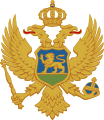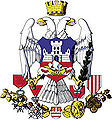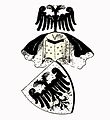- Double-headed eagle
-
- Two-headed eagle redirects here.
Double-headed eagle emblem of the Ecumenical Patriarchate of Constantinople (Istanbul), based on insignia of the Byzantine Empire. The head on the left (West) symbolizes Rome, the head on the right (East) symbolizes Constantinople. The cross and orb in the claws symbolize, respectively, spiritual and secular authority. Relief from the Ecumenical Patriarchate of Constantinople buildings.
The double-headed eagle is a common symbol in heraldry and vexillology. It is most commonly associated with the Byzantine Empire and the Holy Roman Empire. In Byzantine heraldry, the heads represent the dual sovereignty of the Emperor (secular and religious) and/or dominance of the Byzantine Emperors over both East and West. In the Holy Roman Empire's heraldry, it represented the Church and the State. Several Eastern European nations adopted it from the Byzantines and continue to use it as their national symbol to this day, the most prominent being Russia.
Contents
Origins
Double-headed eagles have been present in imagery for millennia. The two-headed eagle can be found in the archaeological remains[1] of the Sumerian civilization and through the Hittite civilization, dating from a period that ranges from the 20th century BC to the 7th century BC. The Gandaberunda is another example of a myhthological two-headed bird, which is in common use in India
Cylindric seals discovered in Bogazkoy, an old Hittite capital in modern-day Turkey, represent clearly a two-headed eagle with spread wings. The aesthetics of this symmetrical position explains in part the birth of this religious figure: It originally dates from circa 3,800 BC, and was the Sumerian symbol for the god of Lagash, Ninurta son of Enlil. It can also be seen in the same region in three monumental settings: Circa 1,900 BC during the Hittite surge from north-central Anatolia down into Babylonia; in Alacahöyük around 1400 BC and in Yazilikaya before 1250 BC. Here the context looks slightly different and totally religious: The eagle returns to its ancient origins as a symbol of divine power. The two-headed eagle is seen less and less during the last Hittite period (from the 9th century BC to the 7th century BC) and totally disappears after the end of the empire.[citation needed]
The double-headed eagle was also in use by the Arsacid Dynasty of Armenia in the 3rd to 9th centuries.[citation needed]
Byzantine Empire
Marble plaque with double-headed eagle in Mystras, marking the spot where the last Byzantine emperor, Constantine XI, was crowned.
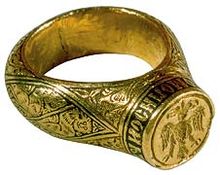 Double-headed eagle on the golden ring of the Serbian Queen Theodora (1296-1322), National Museum of Serbia.
Double-headed eagle on the golden ring of the Serbian Queen Theodora (1296-1322), National Museum of Serbia.
 Example of the use of the eagle on imperial vestments of Theodora Kantakouzene, empress consort of emperor Alexios III of Trebizond. Golden Bull of Alexios III of Trebizond, mid-14th century.
Example of the use of the eagle on imperial vestments of Theodora Kantakouzene, empress consort of emperor Alexios III of Trebizond. Golden Bull of Alexios III of Trebizond, mid-14th century.
Constantinople was the successor of Rome, and the Byzantines continued the use of the old imperial "single-headed" eagle motif. Although the roots of the transformation to double-headed are almost certainly connected with old depictions in Asia Minor, the details of its adoption are uncertain. It was, however, already in use by the 10th century.[citation needed]
The Ancients used no flags in the modern sense. The Romans used various signa, such as the bronze aquilas (adopted as the legions' symbol by Marius) and vexilloids, and, if the emperor was present, pikes or banners with the emperor's portrait. With the adoption of Christianity as state religion during the later Empire, the Chi-Rho and the cross became more and more used in military standards, such as the labarum. The Roman single-headed eagle however continued to be used as a symbol of imperial authority.
According to the most prevalent theory, the single-headed eagle was modified to double-headed by emperor Isaac I Komnenos (1057–1059) being influenced from local traditions about such a (mythical) beast (the haga) in his native Paphlagonia in Asia Minor. Local legends talked about this giant eagle with two heads that could easily hold a bull in its claws; the haga was seen as a representation of power, and people would often "call" it for protection. Isaac Komnenos, deeply influenced by these beliefs, had already used it as a family emblem.[2]
 Emblem of the Seljuk Turks dynasty and the Great Seljuk Empire
Emblem of the Seljuk Turks dynasty and the Great Seljuk Empire
Use by the Seljuk Turks (c.1058–1246)
The double-headed eagle became the standard of the Seljuk Turks with the crowning of Tuğrul (meaning "Falcon") Beg at Mosul in 1058 as "King of the East and the West" and was much used afterwards.[citation needed] The Sultans of Rum, Ala ad-Din Kayqubad I (1220–1237) and his son Kaykhusraw II (1237–1246) used the bicephalous eagle in their standards,[citation needed] and the motif was also found on tissues, cut stones, mural squares, and Koran holders.[3]
Turcomans who ruled in Anatolia during the 13th century, inherited it from the Seljuk Turks. Islamic coins from the reign of Khalif Nasreddin Mahmoud bin Mohammad, following Turkish influence, sporting a double-headed eagle on one side and the Star of David on the other as early as year 1200.
Today, Turkish police have a double-headed eagle in its insignia as a secondary charge, in addition to the Atatürk University in Erzurum, municipality of Diyarbakır and two football clubs of Turkey, Erzurumspor and Konyaspor using it as their coat of arms.
Holy Roman Empire (c.1250–1806)
 Double-headed eagle, reminiscent of the House of Austria, in the petit appartement de la reine in Versailles.
Double-headed eagle, reminiscent of the House of Austria, in the petit appartement de la reine in Versailles.
The first mention of a double-headed eagle in the West dates from 1250, in a roll of arms of Matthew of Paris for Emperor Frederick II of the Holy Roman Empire. Usually depicted black on a gold background, it replaced the earlier single-headed eagle, and was subsequently adopted in the coats of arms of many German cities and aristocratic families. After the dissolution of the Holy Roman Empire in 1806, the double-headed eagle was retained by the Austrian Empire, and served also as the coat of arms of the German Confederation.
Use by other countries
 First Russian eagle, 1472. Adopted by Ivan III after marriage with Byzantine princess Sophia Palaiologina
First Russian eagle, 1472. Adopted by Ivan III after marriage with Byzantine princess Sophia Palaiologina Two-headed eagles on fresco of Serbian Despot Stefan Lazarević (founder's portrait in Manasija monastery, painting by 1413—1418.
Two-headed eagles on fresco of Serbian Despot Stefan Lazarević (founder's portrait in Manasija monastery, painting by 1413—1418.
From Byzantium, two-headed eagles spread to Russia after Ivan III's second marriage to Zoe Palaiologina (a niece of the last Byzantine emperor Constantine XI),[4] and to Montferrat, where a cadet branch of the Palaeologi ruled. It remains also an important motif in the heraldry of the imperial families of Russia (the House of Romanov) and Austria-Hungary (the House of Habsburg), as well as the royal family of Montenegro (the House of Petrovic).
It was the charge in the Coat of Arms of the Bulgarian Tsar Ivan Alexander (reigned 1331–1371).[citation needed] The Serbian Nemanjić dynasty adopted a white version as their own to signify their own independence of, and indeed, claim to the imperial throne of Constantinople. The white eagle was retained by most Serbian medieval dynasties, as well as the Karađorđević, Obrenović and Petrović-Njegoš houses and remains to this day in use in the coat-of-arms of the countries of Serbia and Montenegro. George Kastrioti (Skanderbeg) adopted a similar flag in his struggle against the Ottomans, consisting of a black eagle on red background, which has been resurrected in the current Flag of Albania. During the next centuries, the eagle was made to hold a sword and/or a scepter and an orb with a cross, symbols of the aforementioned double sovereignty.
Its usage also survived as a decorative element in the Greek Orthodox Church, which was the inheritor of the Byzantine legacy during the Ottoman Empire, while it remained a popular symbol among Greeks and is still in use in Church flags. In modern Greece it is used officially by the Hellenic Army (Coat of Arms of Hellenic Army General Staff). It was also used as a charge on the Greek coat of arms for a brief period in 1925–1926.[5]
The two-headed eagle appears on the coat of arms of the following countries and territories:
- Albania (see Coat of arms of Albania)
- Armenia (see Coat of arms of Armenia)
- Austria (1934–1938) (see Coat of arms of Austria)
- Austria-Hungary (historical)
- Byzantine Empire (historical)
- German Confederation (historical)
- Holy Roman Empire (historical)
- Kingdom of Mysore (historical)
- Montenegro (see Coat of arms of Montenegro)
- Republika Srpska (formerly used from 1992 until 2007) in Bosnia and Herzegovina
- Russian Federation (see Coat of arms of Russia)
- Russian Empire (historical)
- Seljuk Empire (historical)
- Serbia and Montenegro (historical)
- Serbia (see Coat of arms of Serbia)
- Nemanjić Serbia (historical)
- Serbian Empire (historical)
- Moravian Serbia (historical)
- Serbian Despotate (historical)
- Kingdom of Serbia (historical)
- Kingdom of Yugoslavia (historical)
- Spanish Empire during the House of Habsburg dynasty (see Coat of arms of Spain)
It also appears on the following coat of arms and flags:
- Flag of Albania
- Flag of Montenegro
- Flag of Serbia
- The flag of the Greek Orthodox Church, which is also used unofficially at the autonomous monastic state of Mount Athos
- Coat of Arms and flag of Hellenic Army General Staff. Also Coat of Arms and flag of Hellenic Army XVI Infantry Division.[6]
- With the addition of Greek letters "Ε Φ" or the label "ΕΘΝΙΚΗ ΦΡΟΥΡΑ" a similar coat of arms is used by the National Guard of the Republic of Cyprus.[7]
- Coat of Arms of the Serbian Armed Forces and all three service branches: Land Forces, Air Force & Air Defence, Training and the administrative General Staff.
- The coat of arms of Belgrade, capital of Serbia
- The Coat of Arms of the city of Valjevo, Serbia
- The coat of arms of the province of Groningen, Netherlands
- The coat of arms of the city of Groningen, Netherlands
- The coat of arms of the city of Nijmegen, Netherlands
- The coat of arms of the town of Bolsward, Netherlands
Use in Masonry
The Double-Headed Eagle of Lagash [there's no double-headed eagle at Lagash] is used as an emblem by the Scottish Rite of Freemasonry.[8] There are many meanings attached to this symbol. It has been introduced in France in the early 1760s as the emblem of the Kadosh degree.[9]
Use in fiction
- In the world of Warhammer 40,000, the double-headed eagle forms the crest of the Imperium of Man, earning it considerable religious and cultural significance. For this reason, it is not too uncommon to create actual double-headed eagles through surgery, mechanical proxy or genetic manipulation. When these are used to aid the abilities of a psyker, they are known as psyber-eagles. The Emperor of Mankind is known to be from central Anatolia, so it may be a reference to his geographic origins.
- In Namco's game, Tales of Symphonia, Aska, a golden, twin-headed bird who is one of the two Summon Spirits of Light is thought to have been inspired by the two-headed eagle. In Ragnarok Online, the double-headed eagle appears in many flags and buildings of the city of Prontera.
- In The Mouse That Roared and its sequels, the double-headed eagle is on the national flag of Grand Fenwick.
- In The Nightly News, a six-issue comic book mini-series by Jonathan Hickman (published by Image Comics), the Brotherhood of The Voice uses a double-headed eagle as one of their symbols.
- In the anime Beyblade, Claude from Barthez Battalion has a beyblade with the bit beast Rapid Eagle which is a two-headed eagle.
- A Roc appeared as a double-headed eagle in the film Sinbad's Seventh Voyage. The same description is used in the online game AdventureQuest.
- The Double-Headed Eagle has sometimes been used as the English title of Jean Cocteau's play L'Aigle à deux têtes.
- In the fictional world of Star Trek, the Romulans and their empire are heavily based on the Roman Empire. The crest of the Romulan Star Empire consist of a creature very similar to a double-headed eagle.
Use in sports
The double-headed eagle is the emblem of the Greek sport clubs A.E.K (black eagle on yellow background, with open wings) and P.A.O.K. (black eagle on white background, with folded wings). It is a symbol of the clubs' origins, since both clubs were founded by Greek refugees who fled to Greece from Constantinople in 1922-23. It is also the emblem of the Turkish Konyaspor [1], the Dutch clubs NEC and Vitesse, the English League Two football club AFC Wimbledon and Scottish Premier League side St.Johnstone F.C.
Use in cults
The double-headed eagle was part of the emblem of the Order of the Solar Temple. This cult was started by Joseph Di Mambro and Luc Jouret in 1984 in Geneva. It gained notoriety in 1994 when members of the cult committed mass suicide and murders in two villages in Switzerland, followed in 1997 by suicide/murders in Canada.
Examples of double-headed eagles
-
Emblem of the Palaiologos dynasty and the Byzantine Empire
-
Coat of arms of a Holy Roman Emperor of the House of Habsburg
-
Coat of Arms of Charles I, during the Spanish Empire.
-
Coat of arms of the Austrian Empire
-
Coat of arms of the German Confederation
-
Coat of arms of the Laskaris dynasty
-
Coat of arms of the Russian Republic
-
(1992-2004) Coat of arms of Montenegro
-
The Seal of Skanderbeg
-
Flag of the Greek Orthodox Church
-
Coat of arms of Lübeck
-
Coat of arms of Velletri
-
Coat of arms of the Province of Rovigo
-
In the upper left (right to the viewer) portion of Coat of arms of Armenia, there is a two-headed eagle, the emblem of the first dynasty to reign over a Christian Armenia, the Arsacid Dynasty of Armenia.
-
Coat of arms of Nijmegen
-
Coat of arms of the House of Montefeltro
-
Flag of Toledo, Spain
-
Coat of arms of Lima
-
Genus Balogh Shield
-
Turkish Sports Club, Konyaspor's logo
-
Genus Balogh Coat of Arms
-

Coat of Arms of the Turkish General Directorate of Security (Turkish police)
-
Greek Sports Club, AEK's logo
-
Greek Sports Club, PAOK's logo
See also
- Double Eagle
- Eagle (heraldry)
- Gandaberunda
- Polycephaly
- Reichsadler
- Coat of arms of Austria-Hungary
- Divide and rule
References
- ^ Gallery.hd.org
- ^ Zapheiriou, N. (1947). The Greek Flag from Antiquity to present. Athens, Greece. pp. 21–22.
- ^ A picture can be found in Titus Burckhardt, Art of Islam, under the chapter on the Rum seljuks.
- ^ Alfred Znamierowski (2003). Illustrated book of Flags. London: Southwater - Annes Publishing Ltd. p. 55. ISBN 1-84215-881-3.
- ^ Eleni Kokkonis-Lambropoulos & Katerina Korres-Zografos (1997) (in greek). Greek flags, arms and insignia (Ελληνικές Σημαίες, Σήματα-Εμβλήματα). E. Kokkonis-G. Tsiveriotis. pp. 47, 51. ISBN 960-7795-01-6.
- ^ Army.gr
- ^ Army.gov.cy
- ^ Scottishritemasons-can.org
- ^ Pierre Mollier (2004), "The Double-Headed Eagle: iconographic sources of the masonic symbol", The Chain of Union (Special issue No.3): 5–15, http://pierre.mollier.perso.sfr.fr/articles/PM-12-Double-Headed-Eagle.pdf, retrieved 2011-10-30
Sources
- (French) Soloviev, A.V. (1935). "Les emblèmes héraldiques de Byzance et les Slaves". Seminarium Kondakovianum 7: 119–164.
External links
- RF.Boom.ru, The development of the use of the double-headed eagle in Russia
- Heraldica.org, Page on the use of heraldry in the Byzantine Empire
- Metmuseum.org, Embroidered double-headed eagle on the podea of Paul, Patriarch of Constantinople (late 14th century) from the New York Metropolitan Museum of Art
National flags and coats of arms National flags National coats of arms Symbols of Greece National symbols National Flag · National Emblem · Hymn to Liberty
Motto: Elefthería í Thánatos · National personifications: Athena, Greece by Delacroix · National holidays: 25 March (1821), 28 October (1940)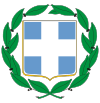
Other symbols Historical symbolsOther official symbolsNatural Monuments Patron Saints Former national symbols Categories:- Heraldic birds
- National symbols of Albania
- National symbols of Austria
- National symbols of Austria-Hungary
- National symbols of Montenegro
- National symbols of Russia
- National symbols of Serbia
- National symbols of Yugoslavia
Wikimedia Foundation. 2010.
























